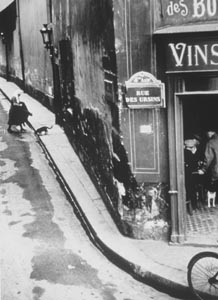![[Metroactive Arts]](/arts/gifs/art468.gif)
[ Arts Index | Metro | Metroactive Central | Archives ]
Light on the Streets
 High Road: 'Paris, rue des Ursins,' a 1931 photograph by Andre Kertesz, is shown in 'Bystander: A History of Street Photography.'
High Road: 'Paris, rue des Ursins,' a 1931 photograph by Andre Kertesz, is shown in 'Bystander: A History of Street Photography.'
A new show at the SJ Museum of Art chronicles the history of street photography By Christopher Gardner THE NEW photography exhibit at the San Jose Museum of Art, Bystander: A History of Street Photography, is not a loud show. It is not bold, big, colorful or controversial. It is a show about everyday life. Slices of living, playing, laughing and working--the pictures in Bystander combine the best of journalism and art to create magic. The exhibit showcases the works of all the great street shooters: Lewis Hine, Cartier Bresson, Bernice Abbot, Alfred Stieglitz, Brassi, Robert Frank, Elliot Erwitt, to name a few. These intrepid photographers, armed with only cameras, film and good shoes, have taken to the streets since the beginning of photography and brought back the images of their times: pure, honest social documents that tell more about life at that particular moment than entire history books ever could. These images are subtle, deep and meant to be viewed up close. They should also be viewed slowly, because there are layers of detail easily missed. As a photojournalist, I view these images with admiration and even awe. There is something very beautiful about going out on a picture hunt with no preconceived images in your head and coming back (if you are lucky) with a captured moment--and if you are good, art. These masters saw the art in the ordinary, captured what is crucial in the seemingly trivial and showed us ourselves. Street photography is as old as photography itself, and Bystander features some very early examples. The pioneering photographers were limited by large cameras and slow film emulsions that required long exposures, constraints that often resulted in staid and stagnant people images. Lewis Hine's Playground in Tenement Alley broke through this limitation and bristles with life. Taken in Boston in 1909, it documents a stickball game in an alley. All around the game, young bystanders watch; overhead, drying laundry hangs between buildings; and in a window, a ghostly figure of one of the mothers is just visible. Some of these images from the show are not terribly important yet are extremely fun. Robert Doisneau's Indignant Woman and A Glance Askance show people's reactions to a painting of a naked woman in a shop's window. Socially significant? No, but would I love them hanging on my wall? You bet. Elliot Erwitt's image of a line of people waiting at an outdoor confessional is serious and amusing in the same glance. Erwitt's Vegas depicts vintage Las Vegas of the 1950s with a woman pulling on a one-armed bandit--literally. OTHER PHOTOGRAPHERS' images lean toward the dark and heavy side. Brassi's untitled photograph of a mysterious woman standing in a dim street with just a hint of a smile on her shadowed face leaves the viewer to wonder about her story. Robert Frank's shot of a New York subway shows one man reading the paper; in another part of the car, a woman commuter is vacantly staring out the window toward the lens. It is a haunting photo that explains nothing yet shows all. On the subject of Robert Frank, one of my all-time favorite images is Frank's photograph of a New Orleans trolley. Trolley, New Orleans is really five pictures in one--at least I view it like that. Taken from the vantage of a sidewalk or curb, it shows five occupied windows. The first window shows a bespectacled man through the glare of the glass. The second frame (or window) reveals a scowling white woman with one eyebrow raised. The third contains two children dapperly dressed--the elder boy looking mature and serious, the younger hanging on the back of the seat. Moving behind them is a dark figure, perhaps their mother. In the fourth frame, a stoic-looking black man with a direct and poignant stare fills the window. Just behind him is a barely discernible man wearing a hat. Finally, in the fifth frame, a smiling, mischievous-looking black woman glances away from the camera, her glasses catching light and her smile doing the same. This very simple photograph has social implications beyond a document of transportation in 1955. Rosa Parks had yet to make her stand by sitting, and this picture illustrates the social pecking order that then existed. A majority of photojournalists (a close relative of the street shooter) know that on every block, around every corner, an image exists. Those who are diligent, prepared and patient can capture these gems. Bystander is worth a walk to the museum--and on the way keep an eye out for art. It is out there.
Bystander: A History of Street Photography runs through April 4 at the San Jose Museum of Art, 110 S. Market St., San Jose. (408/271-6840). Christopher Gardner is Metro's staff photographer. [ San Jose | Metroactive Central | Archives ]
|
From the February 4-10, 1999 issue of Metro.
Copyright © Metro Publishing Inc. Maintained by Boulevards New Media.